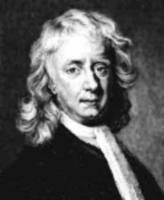History of the INT

- 4 Jan 1643 (new Gregorian calendar)
- Isaac Newton was born in Woolsthorpe-by-Colsterworth, Lincolnshire, England;
- 1661 - Newton joints Trinity College in Cambridge as a sizar;
-
- 1665 - Newton graduates Cambridge University in mathematics (on theories on calculus);
-
- 1687 - Newton published the famous science book The Principia
-
-
- (Mathematical Principles of Natural Philosophy) which includes the universal force gravity;
- 1689 - Newton was elected member of parliament for Cambridge University;
-
- 1670 - Newton started to lecture on optics, studying the light spectrum using a refraction prism;
-
- 1703 - Newton was elected president of the Royal Society, an office he held until his death;
-
- 1705 - Newton was knighted as Sir by Queen Anne of England;
-
- 1727 - Sir Isaac Newton died, being buried in Westminster Abbey, England;
-
- 1942 - Tercentenary celebrations of the birthday of Sir Isaac Newton delayed because of war;
-
- 1945 - Proposal for large telescope for use of all British astronomers;
-
- 1946 - Official celebration of tercentenary of Newton's birth.
-
-
- Announcement that funds voted for construction of 100-inch telescope;
- 1949 - The U.S. McGregor Fund donates 98-inch glass mirror blank;
-
- 1959 - Isaac Newton Telescope (INT) was ordered;
-
- 1965 - First light of INT at Herstmonceux, United Kingdom;
-
- 1967 Dec 1 - INT telescope was inaugurated by Queen Elizabeth II;
-
- 1970 - The Anglo-Australian Telescope (AAT 4m) being built,
-
-
- the English astronomers thinking about Northern hemisphere observatory;
- 1981 - INT telescope was shipped from Herstmonceux to La Palma;
-
- 1982 Dec - The new 100-inch (2.54m) mirror arrives on La Palma;
-
- 1984 Feb 13/14 - First light of INT on La Palma included the Crab and Orion Nebulae
-
-
- and the galaxies M51 and NGC 4151;
- 1985 - The first Prime Focus Camera (WFC) including only one CCD was installed at the INT;
-
- 1985 - The Faint Object Spectrograph (FOS-1) seen first light at the INT;
-
- 1985 Jun 29 - Royal inauguration of the Roque de los Muchachos Observatory (ORM);
-
- 1985 - TAURUS wide-field imaging Fabry-Perot interferometer was installed at the INT;
-
- 1991 - The one chip imaging Pennypacker Camera for at prime focus seen first light at the INT;
-
- 1996 - MUSICOS multi-slit fibre fed echelle spectrograph was installed by ESA in the INT;
-
- 1997 - The actual Wide Field Camera (WFC), a mosaic of 4 CCDs, seen first light on the INT;
-
- 2002 - The IDS spectrograph was installed on the INT;
-
Sir Isaac Newton (1643-1726) was an English physicist, mathematician, astronomer, natural philosopher, alchemist and theologian, who has been considered by many to be the greatest and most influential scientist who ever lived.
His monograph Philosophiae Naturalis Principia Mathematica, published in 1687, laid the foundations for most of classical mechanics. In this work, Newton described universal gravitation and the three laws of motion, which dominated the scientific view of the physical universe for the next three centuries. Newton showed that the motion of objects on Earth and that of celestial bodies is governed by the same set of natural laws: by demonstrating the consistency between Kepler's laws of planetary motion and his theory of gravitation he removed the last doubts about heliocentrism and advanced the scientific revolution. The Principia is generally considered to be one of the most important scientific books ever written, both due to the specific physical laws the work successfully described, and for its style, which assisted in setting standards for scientific publication down to the present time.
Newton built the first practical reflecting telescope and developed a theory of colour based on the observation that a prism decomposes white light into the many colours that form the visible spectrum. He also formulated an empirical law of cooling and studied the speed of sound. In mathematics, Newton shares the credit with Gottfried Leibniz for the development of differential and integral calculus. He generalised the binomial theorem to non-integer exponents, developed Newton's method for approximating the roots of a function, and contributed to the study of power series (introductory of Isaac Newton taken from Expedia)
In the late 1960s, the Anglo-Australian Telescope was being designed, being completed in 1974, and telescopes of comparable power were being contemplated for the Northern hemisphere. The community decided it wanted a suite of three telescopes: a 1.5-m, the 2.5-m INT from Herstmonceux and a new 4.5-m.


